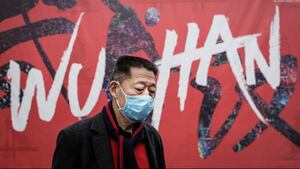China appears to be losing the battle to contain COVID-19, but it’s not yet ready to admit defeat.
Facing the worst national outbreak since the first wave of the pandemic, authorities have introduced lockdown restrictions in cities across the country, with production lines falling idle in the tech hub of Shenzhen and offices shuttered in the financial capital Shanghai.
Under President Xi Jinping, the Chinese government has stuck to a strict zero-COVID policy since the virus emerged in Wuhan in late 2019, locking down entire cities whenever cases emerge and using mass testing and strict quarantining to bring local outbreaks under control.
But Chinese virologists say the arrival of the Omicron variant and its new “stealth” subvariant—both of which appear to evade China’s Sinovac vaccine—could leave that policy in tatters.
For those in the Americas or Europe, the case numbers reported from China still seem pretty small: Authorities confirmed 1,337 new locally transmitted cases in mainland China on Monday. By contrast, the U.K. is currently seeing more than 200,000 cases a day, according to the main COVID tracker.
But the example of Hong Kong, the former British colony that is officially semi-autonomous, is worrying. Omicron appears to be running virtually unchecked through the population of the island territory, which has registered an average of 40,000 cases a day over the past week despite widespread vaccination.
Worst-hit on the mainland is the northeastern province of Jilin, bordering North Korea, where many residents are restricted to their homes except for grocery shopping trips every other day. Jilin has recorded more than 4,000 cases in the past fortnight.
But multiple smaller outbreaks have also been recorded. Shenzhen, a city of 17.5 million people bordering Hong Kong, registered 66 new cases on Saturday, prompting authorities to suspend public transport, close factories—among them the huge Foxconn plant that produces the Apple iPhone. Residents have been told to stay home for the next week except when they are called for three rounds of compulsory testing.
A prominent infectious-disease expert from Shanghai, Zhang Wenhong, said in an article for the Chinese business outlet Caixin that the outbreak was being driven by the Omicron BA.2 “stealth” subvariant, the most infectious lineage yet of the SARS-Cov-2 virus.
Zhang, whose plain-spoken appeals for people to put up with lockdown restrictions at the beginning of the pandemic made him a prominent figure, said that the case numbers suggested the beginning of an “exponential rise”—but China had no option but to try to contain the virus.
“If our country opens up quickly now, it will cause a large number of infections in people in a short period of time,” Zhang wrote, according to a translation carried by the Associated Press. “No matter how low the death rate is, it will still cause a run on medical resources and a short-term shock to social life, causing irreparable harm to families and society.”
Foxconn, Apple’s manufacturing partner, said it would use its “diversified production sites in China” to minimize the impact of the Shenzhen lockdown.
But from a wider economic viewpoint, the lockdowns—both in Shenzhen and the industrial hub of Dongguan—could hardly have come at a worse time. Panic selling saw Chinese tech stocks listed on the Hong Kong exchange fall 11 percent on Monday—their worst single-day fall since the 2008 crash—because of wider fears that China could be dragged into the conflict in Ukraine, or that Chinese companies doing business in Russia might face Western sanctions.
If China sticks with its zero-COVID policy, despite the spread of Omicron, one option is to insist that manufacturers introduce “closed management” systems, where workers live and work in a COVID-free “bubble.” The Chinese used such a system to protect last month’s Winter Olympics in Beijing, where staff and volunteers wore hazmat suits to marshal and test visiting athletes and even robots to feed them. Making that work in a megacity like Shenzhen or Shanghai would be harder.






